The history of world epidemics, part 1
Epidemic (in Greek: ἐπιδημία - general disease, from ἐπι - on, among, and δῆμος - people) in Greek means "general disease among people". Since ancient times, they call diseases that progress in time and space and exceed the normal incidence rate in a given territory. But today we will talk about pandemics - such epidemics that spread over the territory of a whole country, several countries or sometimes even beyond the limits of one continent. These are diseases that have become widespread and affect a significant proportion of the population.
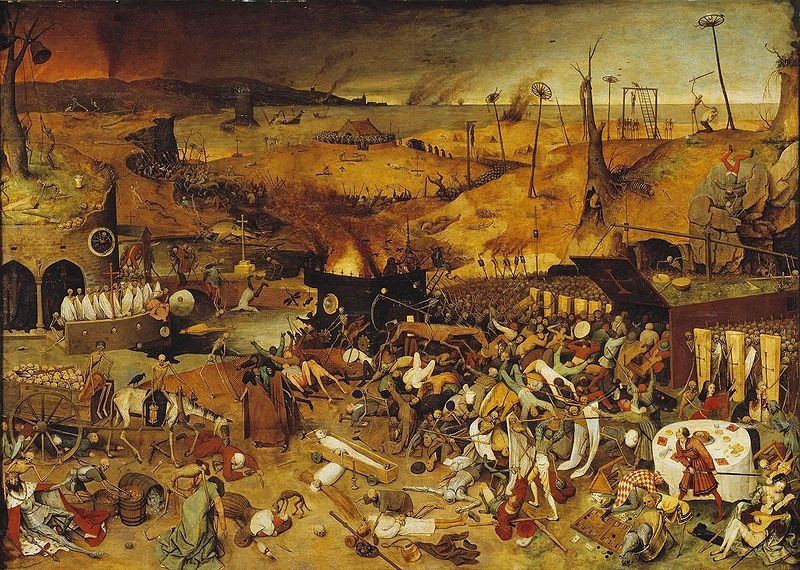
When it comes to epidemics, the “black death” comes first, the pandemic of the plague, decimated a significant part of Europe’s population and passed through North Africa and Greenland in 1346–1353. The first mention of this terrible disease refers to 1200 BC. The event is also described in the Old Testament: Israelis in the war with the Philistines are haunted, after another battle the Philistines seize the Ark of the Covenant and take it to the city of Nitrogen at the feet of the statue of their god Dagon. Soon the plague descends on the city. The ark was sent to another city, where the disease flared up again, and then to the third city, in which the kings of the five cities of Philistea decided to return the relic to the place, fearing new victims. Philistine priests associated this disease with rodents.
“And those who did not die were amazed with growths, so that the cry of the city rose to the skies,” most likely it was about the bubonic plague, which characterizes the appearance of painful growths. The word "bubo" in Greek means "groin". Due to the inflammation, the lymph nodes are enlarged, the outgrowths look like a huge callus, and the first appear in the armpit, groin or on the neck. The same disease is shown in 18 episodes of season 2 of the Dr. House series: “Do not wake a sleeping dog.” The patient becomes infected with a plague for fleas on a puppy, a gift from a friend. The disease is caused by the bacterium Yersinia pestis, carried by fleas, usually parasitic in rats. To save the life of a girl, you have to do a liver transplant.
')
The first recorded global plague epidemic began during the reign of the Byzantine Emperor Justinian I and manifested itself for two centuries from 541 to 750 years. The plague came to Constantinople through the Mediterranean trade channels and spread throughout Byzantium and neighboring countries. In 544, up to 5 thousand people per day died in the capital, sometimes the death rate reached 10 thousand people. Total killed about 10 million people, in Constantinople, 40% of the inhabitants died. The plague did not regret either the common people or the kings - with the level of development of medicine and hygiene nothing depended on the availability of money and lifestyle.
Plague and then repeatedly "raided" the city. This was facilitated by the development of trade. In 1090, merchants brought the plague to Kiev, where they sold 7,000 coffins in a few winter months. Total killed about 10 thousand people. In the plague epidemic of 1096-1270, Egypt lost more than a million inhabitants.
The “black death” of 1346–1353 was the largest and most famous pandemic of the plague. The sources of the epidemic were China and India, the disease reached Europe with Mongolian troops and merchant caravans. At least 60 million people died, in some regions the plague decimated from one third to one half of the population. Later, epidemics recurred in 1361 and 1369. Genetic studies of the remains of the victims of the disease showed that the plague wand yersinia pestis caused the epidemic - before that there was a debate about what kind of disease caused the many deaths during that period. Mortality in the bubonic form of the plague reaches 95%.
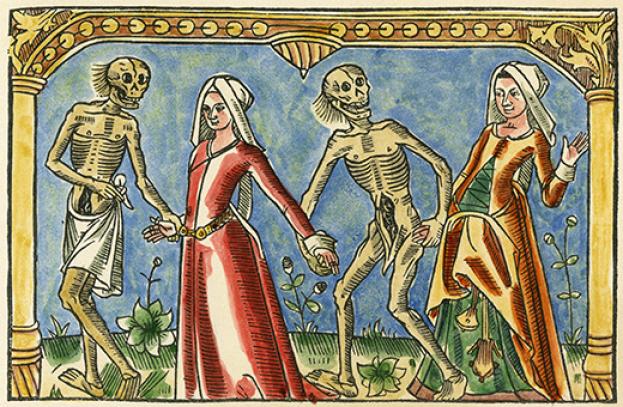
An important role in the spread of the disease in addition to the economic factor, namely trade, was influenced by the social: war, poverty and vagrancy, and environmental: drought, rainfall, and other weather misfortunes. The lack of food caused a decrease in immunity in humans, and also served as a pretext for the migration of rodents that carried fleas with bacteria. And, of course, hygiene in many countries was terrifying (or, simply, out of place) from the point of view of modern man.
In the Middle Ages in the monastic environment was widespread rejection of life pleasures, the conscious punishment of a sinful body. This practice included the refusal to wash: “A healthy body, and especially young ones, should be washed as little as possible,” said St. Benedict. Along the city streets flowed masses of emptied pots. Rats were so common, they communicated so closely with a person that at that time there was a recipe in case a rat would bite or wet someone. Another reason for the spread of the disease was the use of the dead as a biological weapon: during the siege, the fortresses were bombarded with corpses, which allowed the destruction of entire cities. In China and Europe, corpses were dumped into reservoirs in order to infect the settlements.
The third pandemic plague originated in the Chinese province of Yunnan in 1855. It lasted for several decades - by 1959, the number of victims worldwide fell to 200 people, but the disease continued to be recorded. At the end of the 19th and the beginning of the 20th century, outbreaks of plague occurred in the Russian Empire and the USSR, in the USA, India, South Africa, China, Japan, Ecuador, Venezuela and many other countries. During this period, the disease claimed about 12 million lives.
In 2015, scientists discovered traces of yersinia pestis in a flea made from a piece of amber aged 20 million years. The wand is similar to its descendants and is located in the same part of the flea as in the modern distributors of bacteria. Blood spots were found on the proboscis and on the front insects. That is, the distributor of the plague has presumably existed for 20 million years, and was transmitted in the same way throughout this time.
Although we started washing our hands more often and less hugging infected rats, the disease did not disappear. Every year about 2.5 thousand people become sick with plague. Fortunately, the mortality rate dropped from 95% to 7%. Individual cases are recorded almost every year in Kazakhstan, Mongolia, China and Vietnam, Africa, the United States and Peru. In Russia, from 1979 to 2016, not a single plague disease was registered, although tens of thousands of people are at risk of infection in the natural foci. The last case was registered on July 12 - a ten-year-old boy entered the infectious diseases ward with a temperature of 40 degrees.

A miniature on the theme of the bubonic plague in the Bible of the XV century
Mortality from black pox is up to 40%, but recovered people lose their vision in whole or in part, scars from ulcers remain on the skin. The disease is caused by two types of viruses Variola major and Variola minor, with the latter mortality rate of 1-3%. Viruses are transmitted from man to man without the participation of animals, as is the case with the plague. The disease that causes many ulcers on the body - pustules, has been known since the beginning of our era.
The first epidemics were noted in Asia: in the 4th century in China, in the 6th century in Korea. In 737, smallpox caused the death of 30% of Japan’s population. The first evidence of the presence of smallpox in the West is contained in the Koran. In the 6th century, smallpox passed in Byzantium, and afterwards, Muslim Arabs who conquered new lands spread the virus from Spain to India. In the 15th century, almost every person had had smallpox in Europe. The Germans had the saying "Few escape smallpox and love." In 1527, smallpox that came to America claimed millions of lives, she mowed down entire tribes of the aborigines (there is a version according to which conquistadors specially threw blankets infected with smallpox to the Indians).
Osp was compared to plague. Although the death rate of the latter was much higher, smallpox was more familiar - it was constantly present in the lives of people, "filled the cemeteries with deceased, tormenting with constant fear all those who had not yet suffered from it." At the beginning of the XIX century in Prussia annually killed 40 thousand people. One out of every eight patients in Europe died, and among children the chance of dying was one in three. About one and a half million people died every year from smallpox, up to the 20th century.
Mankind started early to take care of the methods of treatment of this terrible disease, different from dressing the patient in red clothes, praying for his health and putting on protective amulets. The Persian scientist Az-Razi, who lived in the second half of the 9th - the first half of the 10th century, in his work “On smallpox and measles” noted his immunity to recurrent disease and mentioned inoculation of light human smallpox. The method consisted of inoculating a healthy person with pus from a ripe pustule of a patient with smallpox.
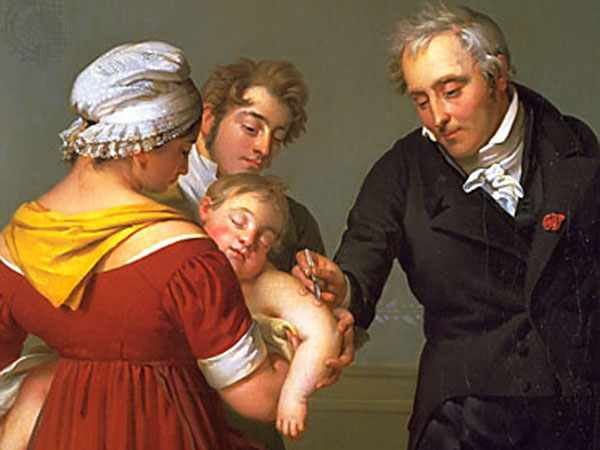
Vaccination against smallpox. 1820 illustration.
The method came to Europe by 1718; it was brought by the spouse of the British ambassador to Constantinople. After experiments on criminals and orphans, smallpox was imparted to the family of the British king, and then to other people on a more massive scale. Vaccination gave 2% mortality, while smallpox killed ten times more people. But there was a problem: the vaccine itself sometimes caused epidemics. Later it turned out that forty years of variolation caused 25 thousand more deaths than black pox for the same period before the start of this method.
At the end of the XVI century, scientists found that cowpox, manifested in the form of pustules in cows and horses, protects a person from being infected with black pox. Cavalry suffered less from smallpox than infantry. Much less often died from the disease of the milkmaids. The first public vaccination of cowpox took place in 1796, when the eight-year-old boy James Phipps got immunity, and he failed to implant natural human smallpox after a month and a half. Soldiers and sailors in 1800 began to be vaccinated on a mandatory basis, and in 1807 Bavaria became the first country where vaccination was mandatory for the entire population.
For vaccination material from pock in one person was transferred to another person. Together with lymph, they transferred syphilis and other diseases. As a result, we decided to use pockish calves as a source material. In the XX century, the vaccine began to dry to make it resistant to temperature. Before that, it was necessary to use including children: in order to deliver smallpox from Spain to North and South America for vaccine, at the beginning of the 19th century, 22 children were used. Two were given smallpox, and after the appearance of pustules, the next two were infected.
The disease has not bypassed the Russian Empire, it has exterminated people since 1610 in Siberia, Peter II died from it. Catherine II was the first inoculated in the country in 1768, who decided to set an example for her subjects. Below is the clan coat-of-arms of a nobleman Alexander Markov-Ospena, who received a nobility for taking vaccination material from his hand. In 1815, a special oprofacial committee was formed, which oversaw the compilation of a list of children and training of specialists.
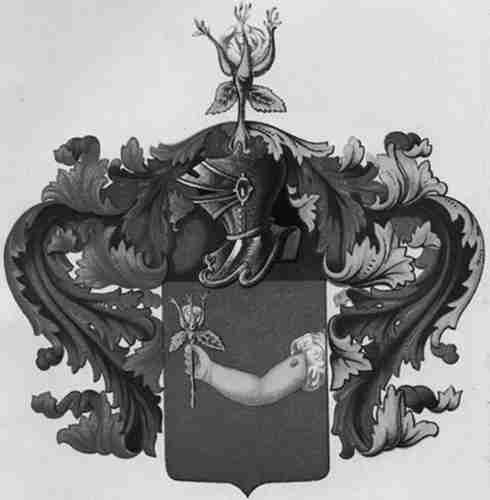
In the RSFSR, the decree on mandatory vaccinations against smallpox was introduced in 1919. Thanks to this decision, the number of cases decreased significantly over time. If in 1919 186 thousand patients were registered, then in 1925 - 25 thousand, in 1935 - slightly more than 3 thousand. By 1936, smallpox was completely eliminated in the USSR.
Outbreaks of the disease were recorded later. Moscow artist Alexander Kokorekin brought the disease from India in December 1959 and “presented” it along with the gifts to his mistress and wife. The artist himself died. During the outbreak, 19 people became infected with it, and another 23 people from them. A flash of death ended for three. To avoid an epidemic, the KGB tracked all of Kokorekin’s contacts and found his lover. The hospital was quarantined, after which the population of Moscow began to be vaccinated against smallpox.
In the 20th century, up to 500 million people died of smallpox in America, Asia and Europe. The last time a smallpox infection was recorded on October 26, 1977 in Somalia. The fact that the disease is defeated, the World Health Organization said in 1980.
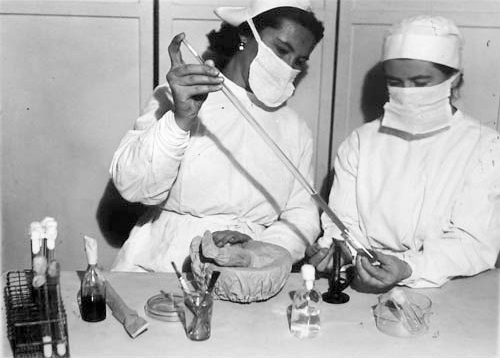
Head of the Laboratory of Smallpox Ovovaccines, S.S. Marennikova (left) at work in boxing. Source: Rospotrebnadzor
At the moment, both the plague and smallpox have remained mostly in test tubes. The incidence of plague, which still threatens some regions, has decreased to 2.5 thousand people a year. Smallpox, passed down from one person to another for thousands of years, was defeated more than thirty years ago. But the threat remains: due to the fact that they are very rarely vaccinated from these diseases, they can easily be used as a biological weapon, which people have already done over a thousand years ago.
In the following articles we will talk about other diseases that claimed the lives of tens and hundreds of millions of people: about cholera, typhus, tuberculosis, marylia, various strains of influenza, leprosy, and HIV.

Plague
When it comes to epidemics, the “black death” comes first, the pandemic of the plague, decimated a significant part of Europe’s population and passed through North Africa and Greenland in 1346–1353. The first mention of this terrible disease refers to 1200 BC. The event is also described in the Old Testament: Israelis in the war with the Philistines are haunted, after another battle the Philistines seize the Ark of the Covenant and take it to the city of Nitrogen at the feet of the statue of their god Dagon. Soon the plague descends on the city. The ark was sent to another city, where the disease flared up again, and then to the third city, in which the kings of the five cities of Philistea decided to return the relic to the place, fearing new victims. Philistine priests associated this disease with rodents.
“And those who did not die were amazed with growths, so that the cry of the city rose to the skies,” most likely it was about the bubonic plague, which characterizes the appearance of painful growths. The word "bubo" in Greek means "groin". Due to the inflammation, the lymph nodes are enlarged, the outgrowths look like a huge callus, and the first appear in the armpit, groin or on the neck. The same disease is shown in 18 episodes of season 2 of the Dr. House series: “Do not wake a sleeping dog.” The patient becomes infected with a plague for fleas on a puppy, a gift from a friend. The disease is caused by the bacterium Yersinia pestis, carried by fleas, usually parasitic in rats. To save the life of a girl, you have to do a liver transplant.
')
The first recorded global plague epidemic began during the reign of the Byzantine Emperor Justinian I and manifested itself for two centuries from 541 to 750 years. The plague came to Constantinople through the Mediterranean trade channels and spread throughout Byzantium and neighboring countries. In 544, up to 5 thousand people per day died in the capital, sometimes the death rate reached 10 thousand people. Total killed about 10 million people, in Constantinople, 40% of the inhabitants died. The plague did not regret either the common people or the kings - with the level of development of medicine and hygiene nothing depended on the availability of money and lifestyle.
Plague and then repeatedly "raided" the city. This was facilitated by the development of trade. In 1090, merchants brought the plague to Kiev, where they sold 7,000 coffins in a few winter months. Total killed about 10 thousand people. In the plague epidemic of 1096-1270, Egypt lost more than a million inhabitants.
The “black death” of 1346–1353 was the largest and most famous pandemic of the plague. The sources of the epidemic were China and India, the disease reached Europe with Mongolian troops and merchant caravans. At least 60 million people died, in some regions the plague decimated from one third to one half of the population. Later, epidemics recurred in 1361 and 1369. Genetic studies of the remains of the victims of the disease showed that the plague wand yersinia pestis caused the epidemic - before that there was a debate about what kind of disease caused the many deaths during that period. Mortality in the bubonic form of the plague reaches 95%.

An important role in the spread of the disease in addition to the economic factor, namely trade, was influenced by the social: war, poverty and vagrancy, and environmental: drought, rainfall, and other weather misfortunes. The lack of food caused a decrease in immunity in humans, and also served as a pretext for the migration of rodents that carried fleas with bacteria. And, of course, hygiene in many countries was terrifying (or, simply, out of place) from the point of view of modern man.
In the Middle Ages in the monastic environment was widespread rejection of life pleasures, the conscious punishment of a sinful body. This practice included the refusal to wash: “A healthy body, and especially young ones, should be washed as little as possible,” said St. Benedict. Along the city streets flowed masses of emptied pots. Rats were so common, they communicated so closely with a person that at that time there was a recipe in case a rat would bite or wet someone. Another reason for the spread of the disease was the use of the dead as a biological weapon: during the siege, the fortresses were bombarded with corpses, which allowed the destruction of entire cities. In China and Europe, corpses were dumped into reservoirs in order to infect the settlements.
The third pandemic plague originated in the Chinese province of Yunnan in 1855. It lasted for several decades - by 1959, the number of victims worldwide fell to 200 people, but the disease continued to be recorded. At the end of the 19th and the beginning of the 20th century, outbreaks of plague occurred in the Russian Empire and the USSR, in the USA, India, South Africa, China, Japan, Ecuador, Venezuela and many other countries. During this period, the disease claimed about 12 million lives.
In 2015, scientists discovered traces of yersinia pestis in a flea made from a piece of amber aged 20 million years. The wand is similar to its descendants and is located in the same part of the flea as in the modern distributors of bacteria. Blood spots were found on the proboscis and on the front insects. That is, the distributor of the plague has presumably existed for 20 million years, and was transmitted in the same way throughout this time.
Although we started washing our hands more often and less hugging infected rats, the disease did not disappear. Every year about 2.5 thousand people become sick with plague. Fortunately, the mortality rate dropped from 95% to 7%. Individual cases are recorded almost every year in Kazakhstan, Mongolia, China and Vietnam, Africa, the United States and Peru. In Russia, from 1979 to 2016, not a single plague disease was registered, although tens of thousands of people are at risk of infection in the natural foci. The last case was registered on July 12 - a ten-year-old boy entered the infectious diseases ward with a temperature of 40 degrees.

A miniature on the theme of the bubonic plague in the Bible of the XV century
Smallpox
Mortality from black pox is up to 40%, but recovered people lose their vision in whole or in part, scars from ulcers remain on the skin. The disease is caused by two types of viruses Variola major and Variola minor, with the latter mortality rate of 1-3%. Viruses are transmitted from man to man without the participation of animals, as is the case with the plague. The disease that causes many ulcers on the body - pustules, has been known since the beginning of our era.
The first epidemics were noted in Asia: in the 4th century in China, in the 6th century in Korea. In 737, smallpox caused the death of 30% of Japan’s population. The first evidence of the presence of smallpox in the West is contained in the Koran. In the 6th century, smallpox passed in Byzantium, and afterwards, Muslim Arabs who conquered new lands spread the virus from Spain to India. In the 15th century, almost every person had had smallpox in Europe. The Germans had the saying "Few escape smallpox and love." In 1527, smallpox that came to America claimed millions of lives, she mowed down entire tribes of the aborigines (there is a version according to which conquistadors specially threw blankets infected with smallpox to the Indians).
Osp was compared to plague. Although the death rate of the latter was much higher, smallpox was more familiar - it was constantly present in the lives of people, "filled the cemeteries with deceased, tormenting with constant fear all those who had not yet suffered from it." At the beginning of the XIX century in Prussia annually killed 40 thousand people. One out of every eight patients in Europe died, and among children the chance of dying was one in three. About one and a half million people died every year from smallpox, up to the 20th century.
Mankind started early to take care of the methods of treatment of this terrible disease, different from dressing the patient in red clothes, praying for his health and putting on protective amulets. The Persian scientist Az-Razi, who lived in the second half of the 9th - the first half of the 10th century, in his work “On smallpox and measles” noted his immunity to recurrent disease and mentioned inoculation of light human smallpox. The method consisted of inoculating a healthy person with pus from a ripe pustule of a patient with smallpox.

Vaccination against smallpox. 1820 illustration.
The method came to Europe by 1718; it was brought by the spouse of the British ambassador to Constantinople. After experiments on criminals and orphans, smallpox was imparted to the family of the British king, and then to other people on a more massive scale. Vaccination gave 2% mortality, while smallpox killed ten times more people. But there was a problem: the vaccine itself sometimes caused epidemics. Later it turned out that forty years of variolation caused 25 thousand more deaths than black pox for the same period before the start of this method.
At the end of the XVI century, scientists found that cowpox, manifested in the form of pustules in cows and horses, protects a person from being infected with black pox. Cavalry suffered less from smallpox than infantry. Much less often died from the disease of the milkmaids. The first public vaccination of cowpox took place in 1796, when the eight-year-old boy James Phipps got immunity, and he failed to implant natural human smallpox after a month and a half. Soldiers and sailors in 1800 began to be vaccinated on a mandatory basis, and in 1807 Bavaria became the first country where vaccination was mandatory for the entire population.
For vaccination material from pock in one person was transferred to another person. Together with lymph, they transferred syphilis and other diseases. As a result, we decided to use pockish calves as a source material. In the XX century, the vaccine began to dry to make it resistant to temperature. Before that, it was necessary to use including children: in order to deliver smallpox from Spain to North and South America for vaccine, at the beginning of the 19th century, 22 children were used. Two were given smallpox, and after the appearance of pustules, the next two were infected.
The disease has not bypassed the Russian Empire, it has exterminated people since 1610 in Siberia, Peter II died from it. Catherine II was the first inoculated in the country in 1768, who decided to set an example for her subjects. Below is the clan coat-of-arms of a nobleman Alexander Markov-Ospena, who received a nobility for taking vaccination material from his hand. In 1815, a special oprofacial committee was formed, which oversaw the compilation of a list of children and training of specialists.

In the RSFSR, the decree on mandatory vaccinations against smallpox was introduced in 1919. Thanks to this decision, the number of cases decreased significantly over time. If in 1919 186 thousand patients were registered, then in 1925 - 25 thousand, in 1935 - slightly more than 3 thousand. By 1936, smallpox was completely eliminated in the USSR.
Outbreaks of the disease were recorded later. Moscow artist Alexander Kokorekin brought the disease from India in December 1959 and “presented” it along with the gifts to his mistress and wife. The artist himself died. During the outbreak, 19 people became infected with it, and another 23 people from them. A flash of death ended for three. To avoid an epidemic, the KGB tracked all of Kokorekin’s contacts and found his lover. The hospital was quarantined, after which the population of Moscow began to be vaccinated against smallpox.
In the 20th century, up to 500 million people died of smallpox in America, Asia and Europe. The last time a smallpox infection was recorded on October 26, 1977 in Somalia. The fact that the disease is defeated, the World Health Organization said in 1980.

Head of the Laboratory of Smallpox Ovovaccines, S.S. Marennikova (left) at work in boxing. Source: Rospotrebnadzor
At the moment, both the plague and smallpox have remained mostly in test tubes. The incidence of plague, which still threatens some regions, has decreased to 2.5 thousand people a year. Smallpox, passed down from one person to another for thousands of years, was defeated more than thirty years ago. But the threat remains: due to the fact that they are very rarely vaccinated from these diseases, they can easily be used as a biological weapon, which people have already done over a thousand years ago.
In the following articles we will talk about other diseases that claimed the lives of tens and hundreds of millions of people: about cholera, typhus, tuberculosis, marylia, various strains of influenza, leprosy, and HIV.
Source: https://habr.com/ru/post/372815/
All Articles